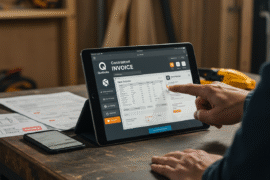This article may contain references to products or services from one or more of our advertisers or partners. We may receive compensation when you click on links to those products or services. Nonetheless, our opinions are our own.
The information presented in this article is accurate to the best of our knowledge at the time of publication. However, information is subject to change, and no guarantees are made about the continued accuracy or completeness of this content after its publication date.
It can be hard to plan for retirement as a self-employed person, especially if you don’t have access to traditional employer-sponsored plans. The IRS offers options that are perfect for entrepreneurs, freelancers, and small business owners. The Solo 401(k) and the SEP IRA are two of the most popular ones. Both plans have big tax benefits and flexible contribution limits, but they are set up differently, have different features, and offer different long-term benefits.
We’ll explain the main differences between a Solo 401(k) and a SEP IRA, such as how much you can contribute, the tax benefits, the penalties for taking money out early, and which one is best for you based on your business structure and income. The first step toward building long-term financial security is to learn how these plans work, whether you want a simple retirement plan or want to make the most of your savings with catch-up contributions.
- Highlights
- Basics of Solo 401(k) and SEP IRA for Self-Employed Individuals
- Looking at Limits on Contributions and Tax Benefits for Your Retirement Plan
- Rules and Penalties for Withdrawals: Things You Need to Know
- Choosing the Right Retirement Plan for Your Business and Income
- Thinking About Future Growth: Tips to Increase Your Retirement Savings
- Switching Accounts: When to Change from a SEP IRA to a Solo 401(k)
- Conclusion
- Frequently Asked Questions
- Recommended Reads
Highlights
- A clear view of the Solo 401(k) and SEP IRA for self-employed individuals
- Limits on contributions, tax benefits, and withdrawal rules are clearly explained
- Helpful tips for choosing the right retirement account based on income and business structure
Basics of Solo 401(k) and SEP IRA for Self-Employed Individuals
It can be hard to plan for retirement when you work for yourself. But it is very important for your future. There are a number of ways to save for retirement. The Solo 401(k) and the SEP IRA are two well-known options. Both have pros and cons that make them good for self-employed people, but it can be hard to choose the right one. This makes both choices clear. It looks at how much they can give, how taxes affect them, and the rules for taking money out. This way, you can choose the best option for your retirement goals.
If you want to start your own business or improve your retirement plan, it’s important to know about these two important choices. Knowing the differences between the SEP IRA and the Solo 401(k) will help you plan for retirement more clearly.
It can be hard to keep track of retirement accounts when you’re self-employed. But knowing your choices, such as a Solo 401(k) or a SEP IRA, can help you reach your financial goals. Both accounts have great benefits, but they meet different needs. One big difference is that you can contribute to a Solo 401(k) as both an employee and an owner. This means that in 2023, you could save up to $66,000 for retirement, or $73,500 if you are 50 or older. This can really help you save for retirement, especially if your income changes during the year.
It can be hard to keep track of retirement accounts when you’re self-employed. But knowing your choices, such as a Solo 401(k) or a SEP IRA, can help you reach your financial goals. Both accounts have great benefits, but they meet different needs. One big difference is that you can contribute to a Solo 401(k) as both an employee and an owner. This means that in 2023, you could save up to $66,000 for retirement, or $73,500 if you are 50 or older. This can really help you save for retirement, especially if your income changes during the year.
Here’s a quick comparison of the two:
| Feature | Solo 401(k) | SEP IRA |
|---|---|---|
| Eligibility | Self-employed individuals or business owners | Self-employed individuals and small business owners |
| Employee Contribution | Yes, up to $22,500 ($30,000 if age 50+) | No |
| Employer Contribution | Yes (as the owner) | Yes (limited to 25% of income) |
| Annual Contribution | Up to $66,000 ($73,500 if age 50+) | Up to $66,000 |
By looking at these differences, you can choose which plan is best for your retirement. Whether you prefer the flexibility and higher limits of a Solo 401(k) or the simple setup of a SEP IRA, knowing what each one offers can help you build a more secure future.
Looking at Limits on Contributions and Tax Benefits for Your Retirement Plan
When you want to get the most from your retirement savings and tax breaks, it is important to understand the differences between a Solo 401(k) and a SEP IRA. This knowledge can greatly affect your financial future.
With a Solo 401(k), you can contribute as both an employee and an employer. This means you can save more each year. In 2023, you can contribute up to $22,500 as an employee. If you are 50 or older, you can also add an extra $7,500.
If you work for yourself, you can add another 25% of your net income to your employer’s income. This brings your total contribution limit up to $66,000, or $73,500 if you make catch-up contributions.
In contrast, a SEP IRA is a simpler way to save. You can contribute up to 25% of your earnings, but the total cannot exceed $66,000 for 2023. While this provides a solid option, it lacks the dual-contribution structure that makes Solo 401(k)s more appealing. Both plans allow for tax-deductible contributions. Your decision may depend on your earnings and whether you plan to hire employees in the future.
Here’s a quick comparison of benefits:
| Feature | Solo 401(k) | SEP IRA |
|---|---|---|
| Employee Contribution | $22,500 + catch-up | N/A |
| Employer Contribution | 25% of net earnings | 25% of net earnings |
| Total Contribution Limit | $66,000 + catch-up | $66,000 |
| Flexibility for Employees | Can add employees | Easy to set up |
| Loan Options | Available | N/A |
These features help you create a retirement plan that fits your income, goals, and lifestyle.
Rules and Penalties for Withdrawals: Things You Need to Know
When you put money into a Solo 401(k) or a SEP IRA, it is important to know the rules for withdrawing funds and any penalties you may face. Taking money out too early can lead to unexpected costs. Here are some key things to consider:
Early Withdrawal Penalties: If you take money out before age 59½, you may face a 10% penalty, along with regular income tax.
Loan Options: Solo 401(k) plans allow loans of up to 50% of your vested balance or $50,000, whichever is less. Loans are not available with SEP IRAs.
Hardship Withdrawals: Both plans allow for hardship withdrawals under specific rules, but the qualifying criteria may differ.
Comparison:
| Feature | Solo 401(k) | SEP IRA |
|---|---|---|
| Early Withdrawal Penalty | 10% before age 59½ | 10% before age 59½ |
| Loan Availability | Yes, up to $50,000 | No |
| Hardship Withdrawals | Yes, under specific criteria | Yes, under specific criteria |
Knowing these details helps ensure you’re prepared for both expected and unexpected financial needs while keeping your retirement funds safe.
Voted "Best Overall Budgeting App" by Forbes and WSJ
Monarch Money helps you budget, track spending, set goals, and plan your financial future—all in one app.
Get 50% OFF your first year with code MONARCHVIP
Choosing the Right Retirement Plan for Your Business and Income
The best retirement plan for you will depend on how your business works and how much money you make. The Solo 401(k) and the SEP IRA are usually the best choices for people who are self-employed, like sole proprietors or single-member LLCs. Depending on your needs, each has its own set of benefits.
Solo 401(k): A smart choice for those who want higher savings potential and are eligible for catch-up contributions at age 50 or older. You can contribute both as an employee and an employer, which adds flexibility if your income varies year to year.
SEP IRA: Ideal for those who prefer a simpler setup. Contributions are based solely on business income. It’s easy to manage and offers tax deductions, which is helpful if your earnings change or you want less paperwork.
| Feature | Solo 401(k) | SEP IRA |
|---|---|---|
| Maximum Contribution | Employee: $22,500 (+$7,500 catch-up); Employer: up to 25% | 25% of income; capped at $66,000 |
| Eligibility | Self-employed individuals with no employees | Self-employed individuals and small business owners |
| Loan Options | Available | Not available |
Your final choice depends on your current income, business model, and retirement goals. Reviewing your finances will help you choose a plan that works best for your future.
Thinking About Future Growth: Tips to Increase Your Retirement Savings
Maximizing your retirement savings means choosing the right plan for your needs. Both Solo 401(k)s and SEP IRAs can support your goals, but they offer different features.
With a Solo 401(k), you can contribute more by acting as both the employee and employer. This is ideal if you’re trying to save aggressively or are near retirement age and eligible for catch-up contributions.
If you prefer a simpler plan that’s easier to manage, a SEP IRA could be a good fit. It allows large contributions based on income, with less paperwork involved.
| Feature | Solo 401(k) | SEP IRA |
|---|---|---|
| Contribution Limits | Up to $66,000 (2023), combining both contributions | Up to $66,000 (2023), based on income |
| Employee Contributions | Yes, up to $22,500 (2023) | No |
| Catch-Up Contributions | Yes, $7,500 if age 50+ | No |
| Tax Deductibility | Contributions reduce your taxable income | Contributions reduce your taxable income |
| Loan Option | Available | Not available |
You can choose one or both of these options by looking at your income, retirement timeline, and goals.
Switching Accounts: When to Change from a SEP IRA to a Solo 401(k)
Switching from a SEP IRA to a Solo 401(k) can be beneficial if your income grows or your needs change. You might consider switching if:
- You’re hitting contribution limits: A Solo 401(k) allows you to save more through combined contributions.
- You want more flexibility: Solo 401(k) plans offer loans and a broader range of investment choices.
- You’re over 50: Catch-up contributions can help boost your savings.
Reassessing your financial goals and growth plans can help you decide if this change supports your long-term retirement strategy.
Conclusion
Your income, business goals, and how much you want to be involved in managing your retirement plan will help you decide between a Solo 401(k) and a SEP IRA. A Solo 401(k) is great for people who make a lot of money or are close to retirement age because it lets them contribute more, take out loans, and make catch-up contributions. On the other hand, a SEP IRA is easier to set up and manage, which makes it a great choice for people who want to keep things simple and make good annual contributions.
Both plans are great ways to help you grow your money without having to pay taxes and give you financial freedom in the future. You can choose the option that best fits your financial goals by looking at your current income, business structure, and retirement timeline. You can also change it over time as your situation changes.
Frequently Asked Questions
What is a Solo 401(k)?
A Solo 401(k) is a retirement savings plan for self-employed individuals or business owners without full-time employees (except a spouse). It allows high contributions from both the individual and the business owner.
What is a SEP IRA?
A SEP IRA, or Simplified Employee Pension Individual Retirement Account, allows business owners to contribute to their own retirement and that of their employees. It is simple to set up and maintain.
What are the maximum contribution amounts?
In 2023, you can contribute up to $66,000 to a Solo 401(k), or $73,500 if age 50 or older. For a SEP IRA, you can contribute up to 25% of your compensation, capped at $66,000.
How do the tax benefits compare?
Both accounts offer tax-deferred growth. A Solo 401(k) also offers Roth contributions, which adds flexibility in your tax strategy.

Reviewed and edited by Albert Fang.
See a typo or want to suggest an edit/revision to the content? Use the contact us form to provide feedback.
At FangWallet, we value editorial integrity and open collaboration in curating quality content for readers to enjoy. Much appreciated for the assist.
Did you like our article and find it insightful? We encourage sharing the article link with family and friends to benefit as well - better yet, sharing on social media. Thank you for the support! 🍉
Article Title: Solo 401(k) vs. SEP IRA: An In-Depth Comparison for Self-Employed Retirement Planning
https://fangwallet.com/2025/07/21/solo-401k-vs-sep-ira-an-in-depth-comparison-for-self-employed-retirement-planning/The FangWallet Promise
FangWallet is an editorially independent resource - founded on breaking down challenging financial concepts for anyone to understand since 2014. While we adhere to editorial integrity, note that this post may contain references to products from our partners.
The FangWallet promise is always to have your best interest in mind and be transparent and honest about the financial picture.
Become an Insider

Subscribe to get a free daily budget planner printable to help get your money on track!
Make passive money the right way. No spam.
Editorial Disclaimer: The editorial content on this page is not provided by any of the companies mentioned. The opinions expressed here are the author's alone.
The content of this website is for informational purposes only and does not represent investment advice, or an offer or solicitation to buy or sell any security, investment, or product. Investors are encouraged to do their own due diligence, and, if necessary, consult professional advising before making any investment decisions. Investing involves a high degree of risk, and financial losses may occur including the potential loss of principal.
Source Citation References:
+ Inspo
There are no additional citations or references to note for this article at this time.












































